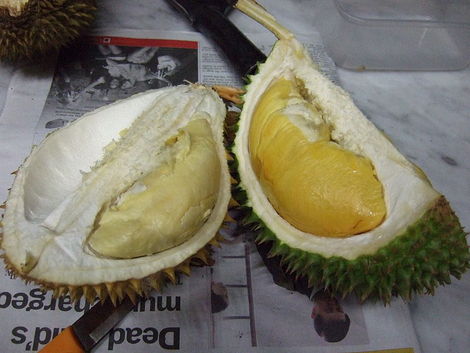The durian fruit is either something you can’t wait to sink your teeth into, or the bane of your existence. It’s all over South East Asia and, if you haven’t seen one before, once you’ve smelled one you’ll never forget it. If you love it, it smells like the sweetest nectar. If you hate it, it smells like the worst sweaty socks you’ve ever smelled, and the taste leaves a feeling at the back of your throat like week-old vomit. For some, it’s like cocaine, they can’t get enough of it. For others, like me, one smell sends me running to the opposite side of the supermarket and would I taste it again? Forget it.
Nutritionally though, it can be good for you as it’s loaded with potassium, Vitamin C and tryptophan. It is also high in protein, carbohydrates and fat, so to some extent is the perfectly balanced food. Some doctors have warned against eating too much of it because of the high fat content. Others have said eat to your heart’s content as the fat is actually ‘good fat’. At 150 calories for 3.5 ounces though, if you’re watching your weight, it’s probably not the fruit for you.
So how do you spot a durian? Look for a very large fruit that is yellowy green in color and has big spikey thorns on the outside. When it’s cut open, the fruit inside is either a bright or pale yellow (depending on the type) and looks like mushy custard, although, if you haven’t smelled one before, you’ll know what it is the minute it’s cut open. To tell whether or not it’s fresh, look for the husk to be cracked or, if you shake it, you can hear the seeds rattling around inside, which means it’s ready to eat.
Durian is one of the most popular fruits all over South East Asia. Here in Thailand, you can find it at every market stall and in every supermarket. Sometimes it’s cut fresh while you wait, other times it is already cut and available in plastic covered containers – which does lessen the smell a little. Thailand is also the world’s largest exporter of durian, growing over 780,000 metric tons of durian every year. The small-time farmers who produce durian even use monkeys to gather the fruit, although I’ve heard they tend to lose some of their crop as monkeys love the taste of durian.
Durian is served in many different ways. You can serve it on its own, but in most places in Asia it is eaten either on things or in things. Durian with sticky rice (glutinous rice) and coconut milk is very popular as a dessert. You can also find it in cookies, cakes, candy and ice cream (I once made the mistake of getting a durian ice cream, thinking it was mango – completely ruined my palate for the rest of the day!) It is also added to some soups in Malaysia and Thailand to give them a more pungent flavor.
Durian is known as the “King of the Fruits”, and Thailand even used the name ‘Durian’ to name one of the tropical cylones in the region. Whatever you think of durian, you should at least try it once in your life. It’s one of those flavors you will never forget and guaranteed you will become an instant convert or a lifetime hater, because there’s never anything in between with the durian.
In the US and Europe, Durian is usually available in either Asian supermarkets or high-end grocery stores. It can be quite expensive, but it’s worth buying once if only to say you’ve had the experience of eating durian.
But be warned, if you buy durian in South East Asia you will not be allowed on most forms of public transportation, nor will many hotels allow it inside the building because of the pungent odor. Therefore, the best way to eat it is to buy it and consume it immediately. That way you’re not forced to walk home, carrying a lot of very heavy fruit!

